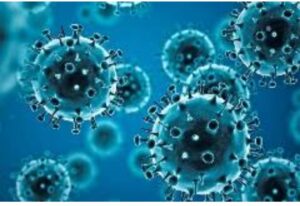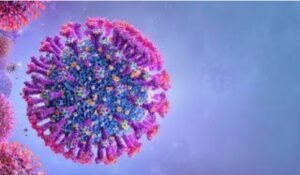CORONA VIRUS / COVID – 19
INCREASED CASES MORE THAN -6000 /DAY

google image
The coronavirus, also known as COVID-19, is a highly infectious respiratory illness caused by the novel coronavirus SARS-CoV-2. The virus was first identified in December 2019 in Wuhan, China, and has since spread rapidly across the globe, resulting in a global pandemic.
The symptoms of COVID-19 can range from mild to severe and may include fever, cough, fatigue, body aches, and difficulty breathing. The virus is primarily spread through respiratory droplets when an infected person talks, coughs, or sneezes. It can also spread through touching a surface contaminated with the virus and then touching your face.
To prevent the spread of COVID-19, it is recommended to wear a mask, practice social distancing, wash your hands frequently, and avoid large gatherings. Vaccines have also been developed and are being distributed worldwide to help combat the pandemic.
The impact of COVID-19 has been widespread, causing illness, death, and economic and social disruption. Many countries have implemented measures such as lockdowns and travel restrictions to slow the spread of the virus.

google image
Introduction
The world has been grappling with the COVID-19 pandemic since late 2019, when the virus first emerged in the city of Wuhan, China. Since then, the virus has spread rapidly across the globe, infecting millions of people and causing significant disruptions to daily life. In this script, we will delve into the details of the coronavirus, including its origins, symptoms, transmission, and impact on society.
What is Coronavirus?
Coronaviruses are a family of viruses that can cause respiratory illness in humans. The virus that is causing the current pandemic is known as SARS-CoV-2, which stands for severe acute respiratory syndrome coronavirus 2. This virus is highly contagious and spreads primarily through respiratory droplets when an infected person talks, coughs, or sneezes.
Symptoms of Coronavirus
The symptoms of COVID-19 can range from mild to severe and may include fever, cough, shortness of breath, fatigue, body aches, headache, loss of taste or smell, sore throat, and congestion or runny nose. In some cases, the virus can cause severe respiratory illness, leading to hospitalization and even death.
Transmission of Coronavirus
The virus that causes COVID-19 is primarily spread through respiratory droplets when an infected person talks, coughs, or sneezes. It can also be spread by touching a surface contaminated with the virus and then touching one’s mouth, nose, or eyes. The virus can survive on surfaces for several hours or even days, depending on the surface type and environmental conditions.
Affected Countries
The COVID-19 pandemic has affected almost every country in the world, with more than 220 million confirmed cases and over 4.5 million deaths as of September 2021. The countries with the highest number of confirmed cases include the United States, India, and Brazil, while the countries with the highest death tolls include the United States, Brazil, and India.
Conclusion

google image
The COVID-19 pandemic has had a significant impact on society, causing widespread illness, death, and economic disruption. It has also highlighted the importance of public health measures such as social distancing, mask-wearing, and vaccination to control the spread of infectious diseases. As the world continues to grapple with the pandemic, it is essential to remain vigilant and follow public health guidelines to protect ourselves and those around us.
As of September 2021, the COVID-19 pandemic has affected almost every country in the world. However, the number of cases and severity of the outbreak vary widely between countries. In this script, we will delve into the details of the countries most affected by COVID-19.
- United States
The United States has been hit hard by the COVID-19 pandemic, with over 42 million confirmed cases and more than 675,000 deaths as of September 2021. The country’s response to the pandemic has been heavily politicized, with some states implementing strict public health measures such as mask mandates and business closures while others have lifted restrictions. Vaccination rates have also varied widely between states, with some areas seeing high rates of vaccination while others lag behind.
- India

google image
India has also been heavily impacted by COVID-19, with over 33 million confirmed cases and more than 445,000 deaths as of September 2021. The country experienced a devastating second wave in the spring of 2021, which overwhelmed the healthcare system and led to a high death toll. However, vaccination rates have been increasing in recent months, and the number of new cases has been declining.
- Brazil
Brazil has the third-highest number of confirmed cases and deaths due to COVID-19, with over 21 million cases and more than 587,000 deaths as of September 2021. The country’s response to the pandemic has been controversial, with the government initially downplaying the severity of the outbreak and implementing lax public health measures. Vaccination rates have been improving in recent months, but the country still faces significant challenges in controlling the spread of the virus.
- Russia
Russia has reported over 7 million confirmed cases and more than 190,000 deaths as of September 2021. The country’s vaccination campaign has been relatively successful, with over 40% of the population fully vaccinated. However, the country has faced criticism for underreporting the true number of cases and deaths due to COVID-19.
- United Kingdom
The United Kingdom has reported over 7 million confirmed cases and more than 135,000 deaths as of September 2021. The country was one of the first to implement strict public health measures such as lockdowns and mask mandates, but has also faced criticism for its handling of the pandemic. Vaccination rates have been high in the country, with over 70% of the population fully vaccinated.
Conclusion


google image google image
The COVID-19 pandemic has affected countries all over the world, with varying degrees of severity. While some countries have been successful in controlling the spread of the virus through public health measures and vaccination campaigns, others continue to struggle with high case numbers and deaths. As the world continues to grapple with the pandemic, it is essential to remain vigilant and follow public health guidelines to protect ourselves and those around us.
Top of Form
INDIA
India has been one of the countries most severely affected by the COVID-19 pandemic, with millions of confirmed cases and hundreds of thousands of deaths. In this script, we will delve into the details of how the pandemic has affected India.
- Number of cases
As of September 2021, India has reported over 33 million confirmed cases of COVID-19, making it the second most affected country in the world after the United States. The country has experienced several waves of the pandemic, with the second wave being particularly severe. The number of new cases has been declining in recent months, but the country still faces significant challenges in controlling the spread of the virus.
- Impact on healthcare system
The COVID-19 pandemic has put immense pressure on India’s healthcare system, which has struggled to keep up with the high number of cases. Hospitals have been overwhelmed, and there have been reports of shortages of oxygen, medicines, and other medical supplies. The country has also faced challenges in vaccinating its large population, with supply chain issues and vaccine hesitancy contributing to slow vaccination rates.
- Economic impact
The COVID-19 pandemic has had a significant impact on India’s economy, which was already struggling before the pandemic hit. The country faced a recession in 2020 due to the pandemic, and many businesses have been forced to shut down or lay off workers. The government has implemented several relief measures to support those affected by the pandemic, but the economic recovery remains slow.
- Response to the pandemic
India’s response to the COVID-19 pandemic has been mixed, with some measures proving successful while others have faced criticism. The country implemented a strict nationwide lockdown in March 2020 to try to contain the spread of the virus, but this led to significant economic and social disruption. The government has also faced criticism for its handling of the second wave of the pandemic, which saw a high number of deaths due to shortages of medical supplies and a slow vaccination rollout.
- Vaccination campaign
India has launched one of the largest vaccination campaigns in the world, aiming to vaccinate its entire adult population by the end of 2021. The country has administered over 880 million doses of COVID-19 vaccine as of September 2021, but this is still only a fraction of the population. The government has also faced challenges in addressing vaccine hesitancy and supply chain issues.
Conclusion
The COVID-19 pandemic has had a significant impact on India, affecting the healthcare system, economy, and daily life of its citizens. While the number of new cases has been declining in recent months, the country still faces significant challenges in controlling the spread of the virus and vaccinating its large population. It is essential for the government and citizens to continue to follow public health guidelines and work towards a sustainable solution to the pandemic.







ALL – GOOGLE IMAGES
- We’re all in this together.”
- “Stay home, stay safe.”
- “Stop the spread.”
- “Mask up for a healthier tomorrow.”
- “Stronger together, apart.”
- “Flatten the curve.”
- “We will get through this.”
- “Protect yourself and others.”
- “Wash your hands, save lives.”
- “Stay apart, stay united.”
- “Stay Home, Stay Safe”
- “We’re all in this together”
- “Stop the Spread”
- “Flatten the Curve”
- “Mask Up, Stay Safe”
- “Protect Yourself and Others”
- “In this together, even when we’re apart”
- “Stronger Together, Apart”
- “Don’t let your guard down”
- “Vaccines save lives”
